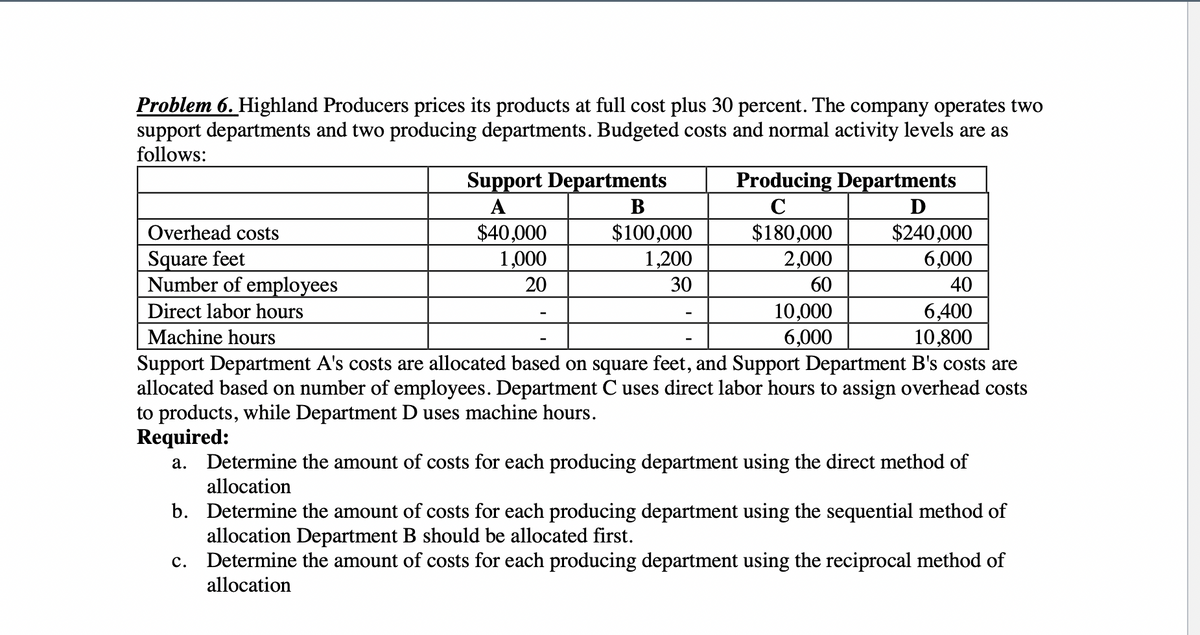Problem 6. Highl_ support departme- ollows:
Managerial Accounting
15th Edition
ISBN:9781337912020
Author:Carl Warren, Ph.d. Cma William B. Tayler
Publisher:Carl Warren, Ph.d. Cma William B. Tayler
Chapter4: Activity-based Costing
Section: Chapter Questions
Problem 2BE: Multiple production department factory overhead rates The total factory overhead for Bardot Marine...
Related questions
Question
100%

Transcribed Image Text:Problem 6. Highland Producers prices its products at full cost plus 30 percent. The company operates two
support departments and two producing departments. Budgeted costs and normal activity levels are as
follows:
Support Departments
Producing Departments
А
B
C
$240,000
6,000
40
6,400
10,800
Support Department A's costs are allocated based on square feet, and Support Department B's costs are
allocated based on number of employees. Department C uses direct labor hours to assign overhead costs
Overhead costs
$40,000
1,000
$100,000
1,200
$180,000
2,000
Square feet
Number of employees
20
30
60
10,000
6,000
Direct labor hours
Machine hours
to products, while Department D uses machine hours.
Required:
Determine the amount of costs for each producing department using the direct method of
allocation
а.
b. Determine the amount of costs for each producing department using the sequential method of
allocation Department B should be allocated first.
Determine the amount of costs for each producing department using the reciprocal method of
allocation
с.
Expert Solution
This question has been solved!
Explore an expertly crafted, step-by-step solution for a thorough understanding of key concepts.
This is a popular solution!
Trending now
This is a popular solution!
Step by step
Solved in 5 steps

Knowledge Booster
Learn more about
Need a deep-dive on the concept behind this application? Look no further. Learn more about this topic, accounting and related others by exploring similar questions and additional content below.Recommended textbooks for you

Managerial Accounting
Accounting
ISBN:
9781337912020
Author:
Carl Warren, Ph.d. Cma William B. Tayler
Publisher:
South-Western College Pub

Survey of Accounting (Accounting I)
Accounting
ISBN:
9781305961883
Author:
Carl Warren
Publisher:
Cengage Learning

Essentials of Business Analytics (MindTap Course …
Statistics
ISBN:
9781305627734
Author:
Jeffrey D. Camm, James J. Cochran, Michael J. Fry, Jeffrey W. Ohlmann, David R. Anderson
Publisher:
Cengage Learning

Managerial Accounting
Accounting
ISBN:
9781337912020
Author:
Carl Warren, Ph.d. Cma William B. Tayler
Publisher:
South-Western College Pub

Survey of Accounting (Accounting I)
Accounting
ISBN:
9781305961883
Author:
Carl Warren
Publisher:
Cengage Learning

Essentials of Business Analytics (MindTap Course …
Statistics
ISBN:
9781305627734
Author:
Jeffrey D. Camm, James J. Cochran, Michael J. Fry, Jeffrey W. Ohlmann, David R. Anderson
Publisher:
Cengage Learning

Managerial Accounting: The Cornerstone of Busines…
Accounting
ISBN:
9781337115773
Author:
Maryanne M. Mowen, Don R. Hansen, Dan L. Heitger
Publisher:
Cengage Learning

Cornerstones of Cost Management (Cornerstones Ser…
Accounting
ISBN:
9781305970663
Author:
Don R. Hansen, Maryanne M. Mowen
Publisher:
Cengage Learning

Principles of Cost Accounting
Accounting
ISBN:
9781305087408
Author:
Edward J. Vanderbeck, Maria R. Mitchell
Publisher:
Cengage Learning